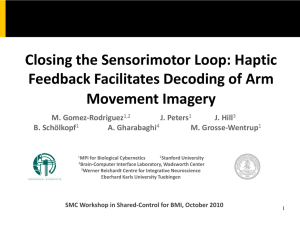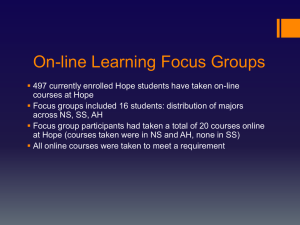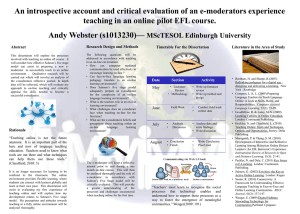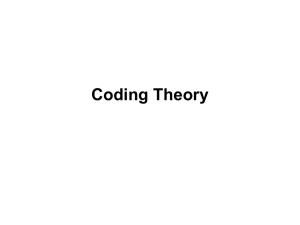Slides
advertisement
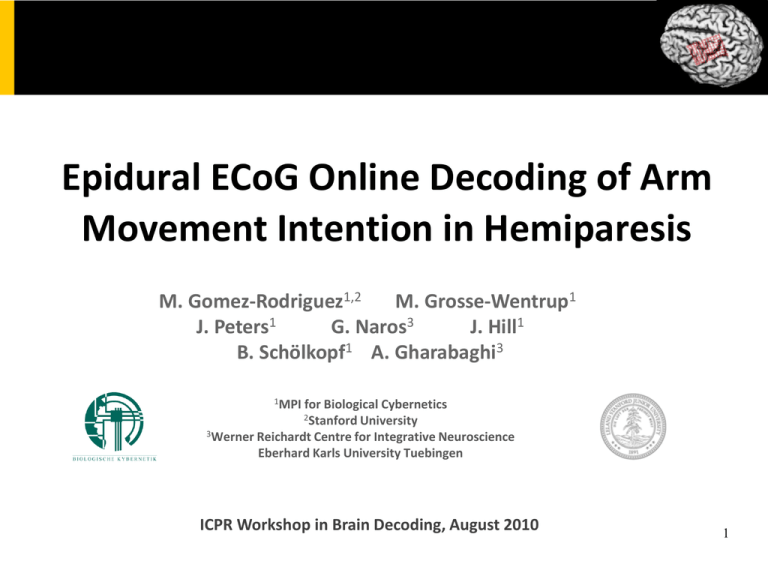
Epidural ECoG Online Decoding of Arm Movement Intention in Hemiparesis M. Gomez-Rodriguez1,2 M. Grosse-Wentrup1 J. Peters1 G. Naros3 J. Hill1 B. Schölkopf1 A. Gharabaghi3 1MPI for Biological Cybernetics 2Stanford University 3Werner Reichardt Centre for Integrative Neuroscience Eberhard Karls University Tuebingen ICPR Workshop in Brain Decoding, August 2010 1 BCI for Neurorehabilitation A Brain Computer Interface (BCI) for neurorehabilitation of: Hemiparetic syndromes due to cerebrovascular, traumatic or tumor-related brain damage. may outperform traditional therapy → Hebbian rule-based [1] Challenges 1. Instantaneous feedback: Synchronize subject’s attempt and feedback 2. High accuracy: User’s control of the BCI 3. High specificity: To focus on specific areas of the cortex 4. Limited invasiveness 2 EECoG for Neurorehabilitation BCI with Epidural Electrocorticography (EECoG) may be a promising tool for neurorehabilitation. Why EECoG for neurorehabilitation? Instantaneous feedback: Delays in the order of ms. High accuracy: On-line decoding of arm movement intention. High specificity: Greater spatial resolution over motor cortex. Limited invasiveness: Safer alternative to intraparenchymal electrodes or subdural devices. Previous studies [2, 3]: Off-line real movement and motor imagery classification and real movement direction decoding using subdural ECoG with epileptic patients. In our work: On-line movement attempt classification using epidural ECoG with a stroke patient. 3 Outline We present a Case Study (one patient) of a BCI with Epidural Electrocorticography (EECoG): 1. Experimental Setup: Human subject, task and recording 2. Methods: Signal processing and on-line decoding techniques 3. Results: Spatial and frequency features and classification performance 4. Conclusions 4 Experimental Setup Human subject: 65-year old male, right-sided hemiparesis (hemorrhagic stroke in left thalamus). Subject’s task: attempt to move the right arm forward (extension) or backward (flexion). Training & test phase in each run, 30 trials per run, 5-s movement + 3-s rest per trial Recording: 96 epidural ECoG platinum electrodes: somatosensory, motor and pre-motor cortex. Limited invasiveness! 8 x 12-electrode grid, 4-mm diameter pad (2.3 mm exposed), 5-mm interelectrode distance. 5 Methods (Signal Processing) Common-Average Reference (CAR), band-pass filtering (2115Hz) & notch filtering (50 Hz power-line). Average power spectral densities over 2Hz frequency bins for each electrode are used as features. Welch’s method over overlapping incrementally bigger time segments each 5-s movement or 3-s resting periods. Larger segments → Less noise and more reliable estimates. Shorter segments → Necessary for on-line feedback. 6 Methods (On-line Decoding) On-line classification (every 300ms) between movement and resting using spectral features: Visual on-line feedback is provided A linear support vector machine (SVM) is generated on-line after a training period (15 seconds of each condition) 7 Results (Spatial and Spectral Features) Discriminative power of each electrode & frequency bin: Operating Characteristic Curve (AUC), 96 electrodes, (2-115) Hz Classifier weights, 35 electrodes, (2-80) Hz High freqs (>40 Hz): Power increases for movement attempt Low freqs (<40 Hz): Power decreases for movement attempt 8 Results (Spatial and Spectral Features) To see discriminative power of each spatial location better: Average AUC for each electrode over: Low freqs (2 - 40 Hz) High freqs (40 - 80 Hz) 9 High Specificity! Results (Performance) On-line decoding of movement intention based on different frequency bands: (2, 40), (40, 80) and (2, 80) Hz High Accuracy! 10 Conclusions We showed the feasibility of epidural ECoG for BCIbased rehabilitation devices for hemiparetic patients Instantaneous feedback: delay of 300 ms. High accuracy: > 85 % in arm movement intention decoding. High specificity: Cortical reorganization caused by the stroke. Limited invasiveness Future work (in progress): EECoG on-line decoding + haptic feedback provided by a robot arm guiding patient’s arm: See already workshop paper at SMC’10 [4] on robot-based haptic feedback using EEG on-line decoding on healthy subjects. 11 References [1] T. H. Murphy, and D. Corbett. Plasticity during stroke recovery: from synapse to behaviour. Nature Review Neuroscience 2009, 10-12, 861-872. [2] T. Pistohl, T. Ball, A. Schulze-Bonhage, A. Aertsen, and C. Mehring. Prediction of arm movement trajectories from ECoG-recordings in humans. Journal of Neuroscience Methods 2008, Vol. 167-1, 105-114 [3] G. Schalk, J. Kubanek, K.J. Miller, N.R. Anderson, E.C. Leuthardt, J.G. Ojemann, D. Limbrick, D. Moran, L.A. Gerhardt, and J.R. Wolpaw. Decoding two-dimensional movement trajectories using electrocorticographic signals in humans. Journal of Neural Engineering 2007, 4-264. [4] M. Gomez-Rodriguez, J. Peters, J. Hill, B. Schölkopf, A. Gharabaghi, and M. Grosse-Wentrup. Closing the Sensorimotor Loop: Haptic Feedback Facilitates Decoding of Arm Movement Imagery. SMC Workshop in Shared-Control for BMI, 2010. 12

